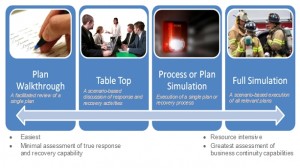
One of the most visible and essential elements of a business continuity program is exercising. Performing exercises enables the organization to validate and improve business continuity capabilities and plan documentation. It is typically recommended that exercises occur at least once a year for every plan, process or procedure, although the actual schedule should consider organizational change and the criticality of the product or service recovered. As organizations are often resource-constrained (e.g. time, money and skills), a number of different types of exercises exist to meet stakeholder requirements while still addressing organizational constraints (see graphic below).
Although exercises vary greatly in type and complexity, selecting the appropriate facilitator is critical. This individual is responsible for establishing a clear exercise plan, summarizing management’s expectations, providing guidance and coaching assistance during the exercise, and capturing constructive feedback from participants after the exercise. Overall, the facilitator is responsible for ensuring the time and resource investment in the exercise is fully realized by the business. The remainder of this perspective addresses those building blocks of a successful facilitation.
Select the Right Facilitator What is a facilitator? A facilitator is the individual chosen to provide oversight and direction during the development and performance of the exercise. A facilitator with the proper knowledge, skill and experience should be selected to lead the development and facilitation of the exercise. Although exercise facilitation experience is important, other important facilitator characteristics include:
- Excellent presentation skills
- Proven leadership abilities
- Knowledge of the business and/or industry
- Understanding of business and location-specific risks
- Sufficient experience with the organization’s business continuity program, especially those elements being exercised
Prepare for the Exercise Once selected, a facilitator should lead (or at a minimum, actively participate in) the development of the exercise. It is recommended that the facilitator be involved in the exercise planning and development process, including:
- Establishing the Exercise Scope – What elements of the business continuity program are being tested? – Who are the participants? – What type of exercise is being conducted?
- Defining Exercise Objectives – What are the overarching goals of the exercise?
- Creating the Exercise Scenario – What information is necessary to increase awareness and enable a thorough evaluation of current-state business continuity strategies?
Set Expectations Just before the start of the exercise, the facilitator should set expectations with the participants in order to increase the effectiveness of the event. Some expectations fall into the category of common sense – no cell phones and one-person speaks at time. Others are considered business continuity-specific – follow the guidance of approved plans and procedures, make actionable decisions as opposed to debating potential actions and defer to the decisions made by the team’s leader. These “rules”, although basic, are often forgotten in the midst of an actual crisis or exercise and without them a delayed or ineffective response or recovery effort could occur.
In addition to setting some ground rules, the facilitator needs to present his/her role in maximizing the value of the exercise, and note that he/she holds the right to redirect the exercise through pre-planned or impromptu information injects. The facilitator must be viewed as a value-added participant – someone that will increase the effectiveness of the training experience, as well as someone trusted to lead a thorough evaluation of the organization’s plans and strategies.
Provide Guidance Once the exercise is underway, it is imperative that the facilitator be bold enough to guide participants back to pre-planned business continuity program elements, yet discreet enough as to not offend participants and prevent further participation. A facilitator should patiently encourage participants to meet the objectives of the exercise and make every attempt to utilize pre-planned program elements and capabilities. The most successful exercises are those that thoroughly utilize the procedures and plans being exercised.
Coach Facilitators should plan periodic breaks for the participants where convenient, but exercise breaks should not be considered “free time.” Instead, these “timeouts” should serve as an opportunity to encourage reflection on how participants are meeting their exercise objectives. A break in the exercise also allows the facilitator time to coach participants for the upcoming segments of the exercise, which is a much more proactive approach to teaching or training participants than just reacting to participants and providing guidance. Exercise “timeouts” leave participants with an increased comfort level (and confidence level) and enhance participant performance through the later stages of the exercise.
Request Feedback Immediately after the exercise, two types of debriefs should be held for all participants. First, each exercise debrief should allow participants to voice their opinion of the actual exercise and its facilitation. In seeking participant opinion, the facilitator gathers ideas or considerations for improving future exercises, while enabling the participants to have a say in the development of their exercises. Facilitators can also choose to distribute feedback forms to gather participant input if time constraints exist.
Secondly, facilitators should use the conclusion of an exercise to log any and all observations for process/plan improvement, including business continuity program capability gaps. These observations should be documented and presented to the appropriate stakeholders within the organization for approval before proceeding. The business continuity program should keep a record of all observations in order to track and note any progress from previous exercises.
In Conclusion While there are a myriad of possible exercise goals, the two overriding objectives are to improve the preparedness of the organization for an actual event and increase individual capabilities to participate in the response and recovery effort. An exercise facilitator is a key element in reaching these two objectives because the facilitator is responsible for leading the exercise preparations, setting clear expectations, refocusing participants towards their exercise objectives, creating convenient teaching opportunities and seeking participant feedback.
Want to hear more from us? Schedule a strategy session with us today!




